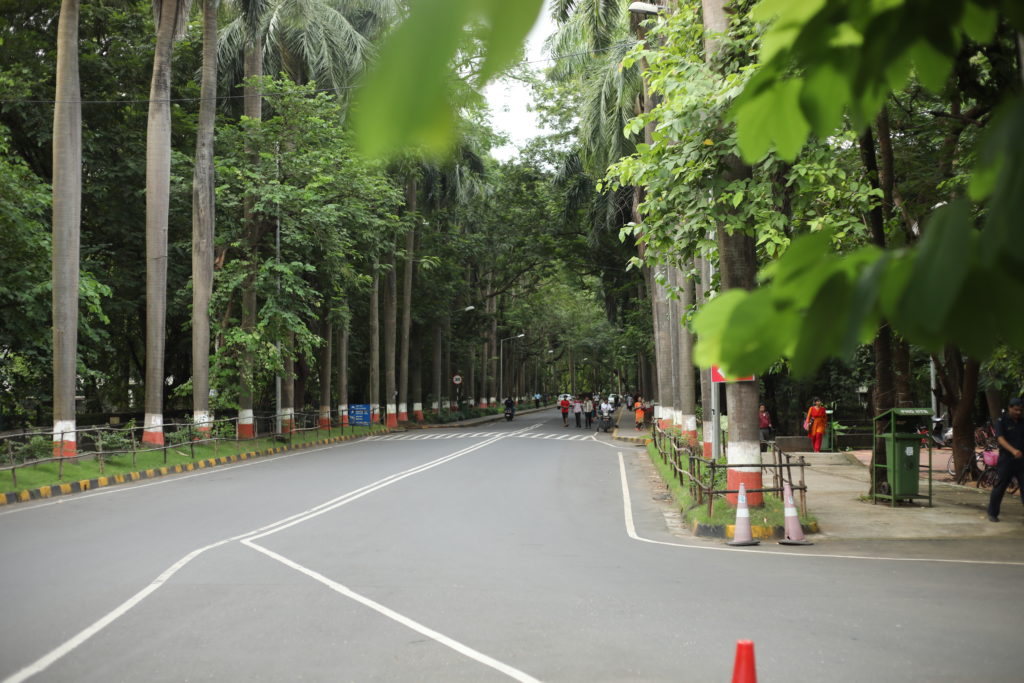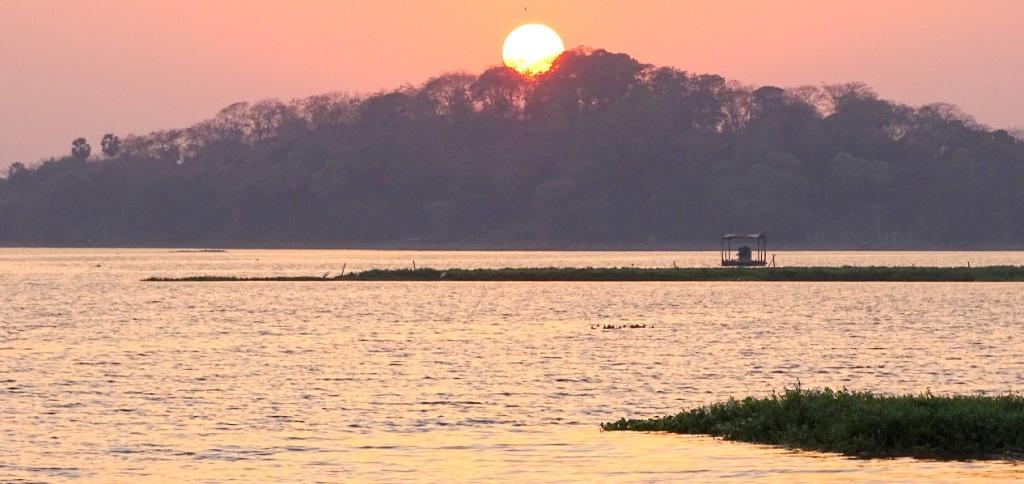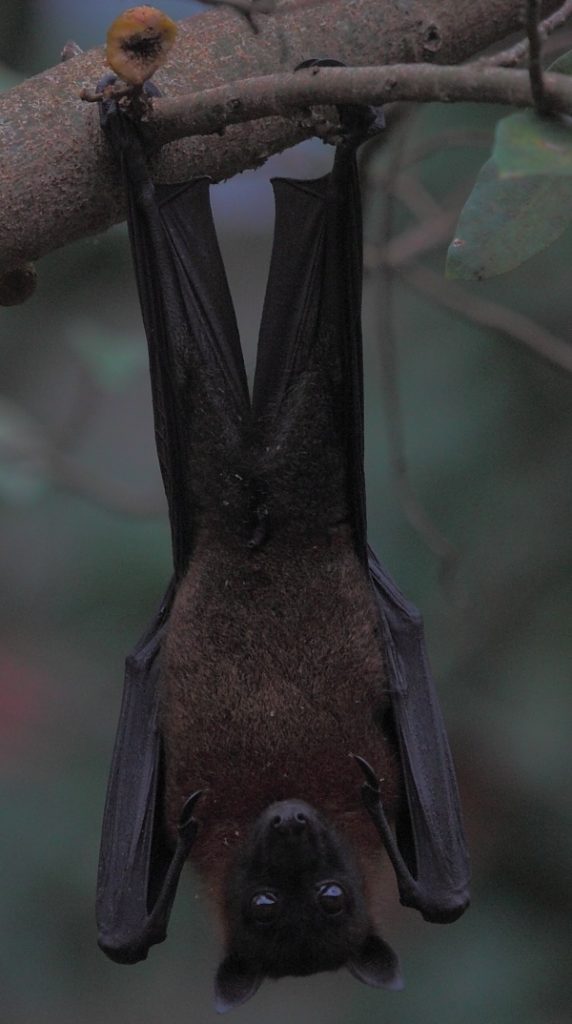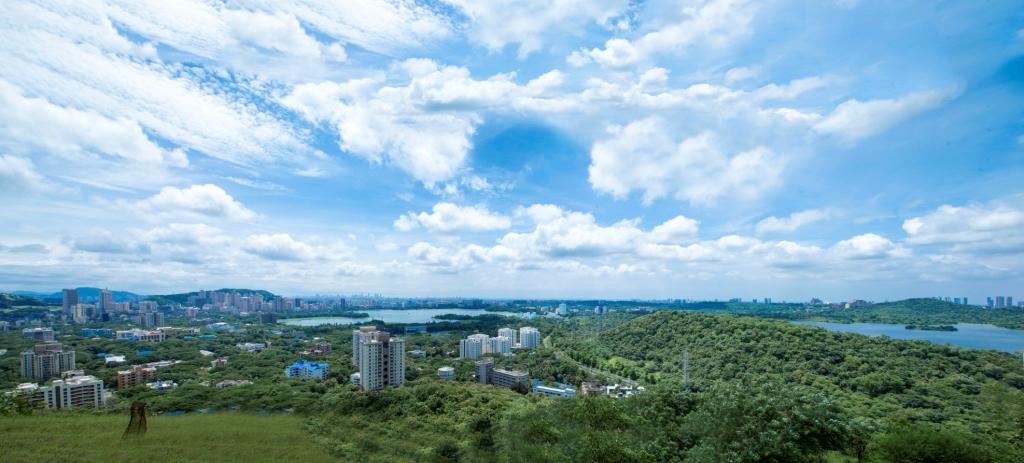Solutions to the Challenges
Make no mistake: IITB has been nature-friendly for years. Visitors have remarked at how pavement and buildings have been built to carefully sidestep existing flora. A particular case in point is the banyan tree within the Lecture Hall Complex that was left untouched when the building was constructed a decade ago. The trees saved at the end of the Infinity Corridor near the Central Library during renovations is another shining example. The ban on motorized vehicles from entering sensitive areas on the campus such as Soneri Baug and the hillside is looked upon by other institutions as a model for emulation. Alumni have pitched in, too — the Soneri Baug Conservation Project, contributed by the Class of 1984, undertook to help better preserve the area for campus residents to enjoy the biodiversity in a tranquil setting. However, the challenges that we’re facing with an increasing student population in the institute as per central government mandates, necessitates us to look at possible solutions to the destruction of the ecosystem for necessary infrastructure
What are possible solutions to development without disturbing too much of nature?

A glaring infrastructure deficit certainly needs to be addressed. Some approaches that may be explored are listed below. The credit for many of these ideas goes to Prof Manchanda and Prof Patil of the Electrical department.
● Going Vertical: The most intuitive solution is to build taller. Indeed, this idea has caught on over the last decade, with G+17 faculty residences such as Ananta and Aravali having come up. The ongoing construction of a twenty-storey plus residential building in the lakeside quarter is another example. This may be implemented across the board, with the latest highrise hostels setting the tone for future such developments.
● Space Efficiency: Several buildings could have been built to use space more efficiently, which would indirectly alleviate biodiversity loss. Prof Patil points out that the new CSE department has features that waste space, such as the expansive staircase atrium in the centre of the building, or the seldom utilized lecture theatre fashioned in the shape of a globe. This globe structure precludes any construction above the ground floor in the area that it occupies. Another egregious example is VMCC, where the large open area atop the first floor — which is rendered unusable for much of the year due to monsoon rains — could have been put to better use. Prof Patil estimates that several dozen faculty offices and laboratories could have been accommodated if multiple stories had been built in place of this open area. Likewise, the recently inaugurated CESE/DESE department is a shell of a building, with a very large atrium where there could otherwise have been office space. Elsewhere, Prof S Shivasubramanian points out that the lawns on the rear of the Main Building serve little purpose and are additionally a drain on water resources. Similarly, large surface parking pavements could be reduced in size or built on stilts.
● Redevelopment and remodeling: All of the senior hostels were built over five decades ago and designed for those times, when annual enrolment was in the low hundreds. Clearly, even after mandatory pairing up of inmates, these hostels can no longer cater to the surging demand for accommodation. The way forward could be to demolish and build taller buildings as replacements, retaining the existing footprint.
Make no mistake: IITB has been nature-friendly for years. Visitors have remarked at how pavement and buildings have been built to carefully sidestep existing flora.
● Second campus: A satellite campus outside the city housing research facilities and accommodation for some doctoral and post-doc students could ease congestion in the Powai campus. Even if all current construction projects are completed on schedule, many PG students including married research scholars would still not be accommodated. Many universities abroad have multiple campuses, while in India, IIT Delhi has already established two satellite campuses in Sonipat and Jhajjar.
● Native over exotic: Native species of plants require far less maintenance than non-native plants do. According to Dr Quadros, native plants attract local fauna as well, enhancing the biodiversity of the area. He also opines that the humble native grass species are also very important like the larger flora, and are not to be neglected. Prof Patil concurs over the need for native species, noting that, ”raintrees, gulmohar and copper pods are not native to this place, and do not support fauna, such as birds and insects. These should gradually be replaced with native trees.”
● Administration’s policies: Implementing the strategy outlined in the IIT Council’s Green Action Plan would be a good way to make a beginning. The institute’s Land use Master plan should be made compliant with environmental norms as well as GRIHA norms for green building. To prevent extravagant architectural plans that waste space from taking shape, Prof Patil suggests that, “the administration, in consultation with all stakeholders, should lay down certain requirements for future buildings (on metrics such as ratio of usable space to footprint) and only designs which satisfy that requirement should be considered.” Further, an environmental plan should be created that would delineate permanent green areas to preserve biodiversity. Greening initiatives must not just be qualitative but should be quantified. For instance, the outcomes (eg.: survival rate of trees) of the annual Vanmahotsav plantation program are not known. This must be surveyed and data regarding all trees on campus should be collected and made public. Finally, the institute can leverage its Institute of Eminence tag to implement sustainable development and become a role model for other institutions across the country.
● Interaction with the Campus Community: There is a need for the Main Building to interact with stakeholders in a transparent manner — including by encouraging consultations on new projects with the campus community, who are the end-users of the infrastructure built. As succinctly put by the Green Action Plan, the institute should make the “greening agenda a participatory, transparent process, seeking to generate greater awareness by sharing reports widely with its campus community and on the institute’s web site.” Ultimately, there is a need for long-term thinking in the form of a continuous plan, because while decisionmakers keep changing, the effect of their policies on the campus landscape is permanent.
● Revival of Green Office: A revived GCI Committee or Green Office (these two terms appear to be used interchangeably in administrative parlance) would be the nodal agency responsible for executing the above activities. Such a committee would meet regularly and fulfill the overarching need for expert opinion on the environmental impact of new projects that could otherwise be missed by oversight. Many of the unimplemented programs of the earlier Committees would also be completed, including conducting green audits and space audits. This committee should have members who are elected by the campus community along with representation from ecologists, who could then be entrusted with organizing a follow-up biodiversity survey to the 2008 WWF one. Empowering the GCI Committee again is a move that would be in consonance with the spirit of the institute’s own Strategic Plan document.

● Alumni Support: As alumni involvement and funding becomes significant, they are increasingly important stakeholders in the future of the institute. There is a need to sensitise alumni about our ecological heritage and get their support for conservation. They could have a say in the conceptualization of new developments. For example, the old design of the Infinity Corridor was retained for the redeveloped version even though it suffered from seepage problems during the monsoon, partly because of alumni requests.
● Stray animals: While stray cows bothering hostel denizens is a thing of the past now, their existence on campus “is still detrimental to overall biodiversity,” Dr. Quadros says. Herds of cattle foraging in the vegetated areas are responsible for overgrazing of native grasses and other forest floor species while also defoliating trees and shrubs. Meanwhile, stray dogs may pose a threat to native wildlife including birds. An effective policy to control the population of stray animals is, therefore, a necessity.
● Feeding Animals: Though it may be a gratifying act, we must be cautious too, says Maithreyi M.R., a campus resident and consulting editor at the Bombay Natural History Society. We have all kinds of birds on the campus – resident, migratory, shy, aggressive, opportunistic, some with habitat restrictions, and some like the crow that eat anything from nestlings to eggs and waste discarded by people. When crows or pigeons are selectively fed, a disadvantage may be created for the other birds. They are wild animals that can fend for themselves. Creating awareness is the key but, to begin with, rules would help, she concludes.
Rapid and unpredictably increasing student numbers is, of course, the elephant in the room. The abrupt increases in student intake are the cause behind many of the chronic infrastructural issues. These external “shocks” began with a 56% increase in overall UG intake as a consequence of the OBC reservations in 2007, followed later by a 20% supernumerary reservation for women students. Most recently, the 10% quota for economically weaker sections has meant that the IITs will have to further increase seats by 25% so that existing reservations remain unaffected.
The cost of suddenly implemented, large increases in intake is reflected in hastily planned infrastructure projects that do not adequately factor in environmental concerns. There is therefore a need for planned growth in intake so that infrastructure can adequately keep up with the demand.
While the advent of the internet has brought in much positive change, it is of concern that as a result, the student of today is slightly less in touch with the environment than before. More of us should get out of our rooms once in a while and explore the wonderful nature that we are immersed in.
Call for Wildlife Club
-

A gene bank! The hilltop hosts diverse wild plants like the Wild Turmeric (Photo courtesy: Aniketa Kabir) -

This fascinating turtle species is part of the thrill one gets in animal tracking. -

At less than 4 inches, the
Purple-rumped Sunbird is one of the busiest residents of the campus. -

A ratsnake scaling up a palm tree by the lake (Photo courtesy: Aniketa Kabir) -

The headstand pose of a hardcore frugivore! A Flying
Fox roosting in its colony at IITB.
There is one thing that seems unusual about this whole biodiversity saga. It doesn’t comply with the IITB tradition of having a student club based around it. As discussed earlier there was indeed such a “Wildlife Club” in the institute since 1977 that engaged in organizing nature walks, exhibitions, talks, awareness programs and much more. The club was wildly popular among the student community during the mid-’80s but slowly faded away into a relic.
Our campus is a unique amalgamation of the busy city of Mumbai and the tranquility of Sanjay Gandhi National Park. Recognising this incredible access we have to Powai Lake, various hills, and remnants of forest area might be one of the most convincing reasons for a call for a Wildlife Club 2.0. Looking forward, the club might be able to bridge the gap between modern lifestyle and the “escape into nature” that we crave from time-to-time.
The introduction of a new club just requires a strong will from a few students and faculty, as the institute authorities have generally been supportive of student initiatives. It is time to reignite the enthusiasm that deep down each of us has to traverse along the road not taken. Such a club could also serve as the focal point for all campus inhabitants to discuss and channelize solutions to environmental challenges occurring in the institute. Nature conservation is a subject that resonates with a wide cross-section of faculty, staff and other campus residents. We have seen this most recently when the proposal to set up a solar power park on Sameer hill was vociferously opposed by a section of campus residents. An active Wildlife Club could bring all nature enthusiasts on campus under one umbrella and help raise awareness regarding these issues.
It may be argued that the furtherance of technological education is what should be our concern and the raising of environmental issues should be accorded less priority. However, we must recognize that IIT Bombay represents a microcosm of the future generation of Indians that shall be at the forefront of the society and nation-building. It is necessary for the students here to be adequately sensitive to threats to the natural environment and their undesirable consequences. As the theme of sustainable engineering gains traction in a world where climate change is increasingly becoming a reality, and there is increasing recognition of the risks of unsustainable development, it is imperative that concern for the environment begins here on campus.
As Dr. Quadros says, “Life forms [except humans] do not have a voice.” Not only should we recognise that the diverse flora and fauna must have a right to exist undisturbed, but also acknowledge that they provide valuable ecosystem services which are intangible in monetary terms. Moreover, the campus environment adds to the overall educational experience of a student and is priceless. Conservation should be accorded due to seriousness, and should not just be confined to token activities such as Vanamahotsav. “Don’t kill green and talk green.” In the end, “we should all leave a better planet for our children,” concludes Dr. Quadros.
Construction in the future should be more inclusive of the campus biodiversity, else we may risk being left with just the trees lining the streets. Then, IIT Bombay as we know it, one of the few ‘green lungs’ of Mumbai, would cease to exist. That would indeed be a sad fate to befall this campus.
This post is an abridged version of a longer piece Biodiversity and IITB published recently by the Insight team. Click here to read the original article online. Alternatively, follow the link provided below to download the .pdf file.
We hope you have enjoyed reading Fundamatics, the award-winning ezine published by the IIT Bombay Alumni Association, envisioned as one that is by IIT Bombay alumni, faculty and students, and for the same vast community. And, the best part of Fundamatics is that it is completely free and can be accessed by thousands of our alumni who are spread all over the world. But this does not mean that we do not incur any operational costs in bringing the ezine to you. Your financial support can mean that we can continue to remain in circulation and “free” to you, our readers.

2 comments
Our Distinguished Alumnus, Prof. Pratim Biswas (1980, B.Tech, ME) responded to this article and shared some interesting anecdotes from his own days at IIT Bombay. They illustrate the sea change that the campus has undergone in the many years that have passed. Please do read!
“I arrived to the campus of IIT Bombay as a child in 1967, moving from NCL Poona as my dad took up a position in the Chemistry Department at IIT Bombay. While the campus did not have the abundance of large trees it has now, I narrate a transformation that took place during every monsoon. With the rainfall, there was a system of gutters (natural) that used to fill up with rainwater gushing into Powai Lake. These water channels were a delight for the campus children, making their paper boats, having races and the like. The most interesting aspect was the spawning of fish from the lake – they swam upstream, laid their eggs, and there would be an abundance of the birth of new fish, that then made their way back into the lake. An ecosystem where frogs thrived was established – and sometimes, the little tadpoles were mistaken for the fish, as the children caught them and took them home in their glass jars. The ecosystem lessons we learnt could not have been taught in any classroom, not to take away anything from the fabulous KVP school that had some excellent teachers. When I walk on campus today, I wonder where the natural water draining system went – probably replaced by underground, engineered concrete/metal pipes that carry the water away. Probably there is a road or walkway built over these water draining systems also – due to the pressures of land use and catering to the growing population that occupies campus today.
Without knowing what a natural wetland was, I experienced one right in front of our house (A-9), where the BTR quarters used to be (I hear those are also being torn down). This area used to fill up with water during the monsoons, and was a delightful ecosystem. This is where I learnt about the beautiful flowering plant – the gloriosa superba (glory lily). Very interestingly, the frogs would take on a yellow color, to attract the opposite sex to then mate and carry on the next generation. What I then thought was cacophony, plays like music in my memory cells today! Today, I understand the importance of natural wetlands; and appreciated watching this every monsoon during my growing up years. Even before I left campus, the wetland was filled up and the BTR quarters were constructed. Two of my dearest friends from class moved in there, and these two folks also went through the five years at IIT B (Mechanical Engr) with me. It was great to have them next door to me, and I understood even then (~ 1975 or so) the conflicting choices between the environment (the wonderful natural wetland) and having my friends living next door to me. As we dispersed in 1980 to different places and have never lived next to each other all these years, I often wonder if some preservation of that natural wetland would have done wonders to all the generation of campus children that followed us. Or for me to revisit the wetland on the campus during a monsoon, and relive those childhood memories.”
Very nicely written Ganesh. Interesting to note the efforts taken by campusites decades ago and to see the satellite.images. I have been in campus for the last 14 years and the change is very discernible. Hope articles like this and efforts like this green issue by Fundamatics are able to put the matter in focus.